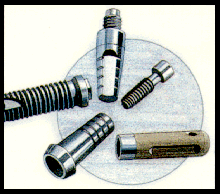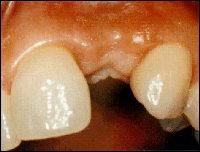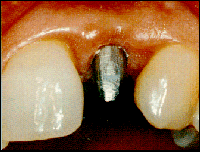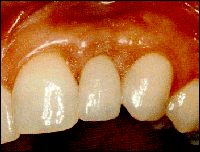|
Please note that the detailed information on these pages graphically describe and
illustrate, to some degree, surgical procedures. We offer this to you because we feel that
you should be fully informed of all procedures, and that you will feel more comfortable
with a better knowledge of exactly what is involved in the implant procedure.
Who makes a good candidate for implants?
 Your mouth should be
examined by both a restorative dentist and an oral surgeon before the decision to perform
the dental implant procedure is made.The surgeon determines the condition of your jaws and
gums while the dentist assesses the fit of the present dentures or the tooth gap. They may
also take X-rays and/or computer images, and the dentist will make replicas of your teeth
and jaws. Your mouth should be
examined by both a restorative dentist and an oral surgeon before the decision to perform
the dental implant procedure is made.The surgeon determines the condition of your jaws and
gums while the dentist assesses the fit of the present dentures or the tooth gap. They may
also take X-rays and/or computer images, and the dentist will make replicas of your teeth
and jaws.
Factors which may affect the decision to use implants include diabetes and allergies,
along with any medications you take, alcohol and drug use, and smoking. Very few medical
conditions actually rule out the use of dental implants. The health of your gums and oral
tissues and the shape of your jaws are also important factors in the decision to use
dental implants.
How do dental implants work?
Dental implantation is a three-stage process:
 |
A first surgery places the implants under your gums, inside the jaw. When the bone
grows in around the implants, they become firmly fixed. This is called biointegration
or osseointegration. In order for osseointegration to occur, the implants must
remain covered for four to six months. |
 |
After the healing period, a second, shorter surgery is performed to expose the
implants and place abutments (securing pins) into the implant shafts. The abutments will
be used to hold the new teeth. |
 |
In the third and final phase, the restorative dentist creates and fits the
replacement teeth to your mouth. This involves making impressions, bite registrations
(aligning the teeth so that they come together correctly), bridge fittings and tooth and
color selection. |
Click here for more detailed information on the
implant process.
Please note that the detailed information pages graphically describe, to some
degree, surgical procedures. We offer this to you because we feel that you should be fully
informed of all procedures, and that you will feel more comfortable with a better
knowledge of exactly what is involved in the implant procedure. We have included diagrams
and some actual photographs of the procedures.
|

 Your mouth should be
examined by both a restorative dentist and an oral surgeon before the decision to perform
the dental implant procedure is made.The surgeon determines the condition of your jaws and
gums while the dentist assesses the fit of the present dentures or the tooth gap. They may
also take X-rays and/or computer images, and the dentist will make replicas of your teeth
and jaws.
Your mouth should be
examined by both a restorative dentist and an oral surgeon before the decision to perform
the dental implant procedure is made.The surgeon determines the condition of your jaws and
gums while the dentist assesses the fit of the present dentures or the tooth gap. They may
also take X-rays and/or computer images, and the dentist will make replicas of your teeth
and jaws. 

